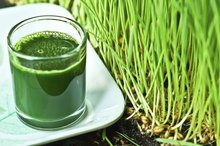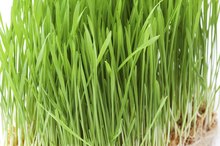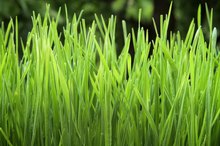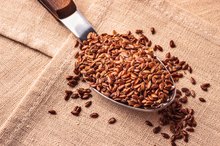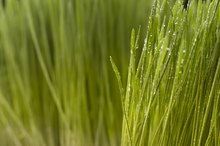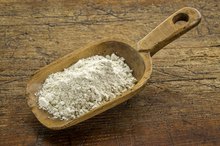Differences Between Wheat Germ & Wheatgrass
Health-conscious eaters have favored wheat germ as well as wheatgrass for many years. These two components of the common wheat plant provide a smorgasbord of healthy minerals, vitamins, enzymes and antioxidants. Although they are both produced by the wheat kernel, wheat germ and wheatgrass have very different forms, appearance and taste.
Wheat Germ Identified
Wheat germ comes from the wheat kernel, but makes up only a tiny portion of the kernel. When it sprouts, wheat germ forms a cotyledon or sprout, which makes up wheat grass. The term “germ” refers to germination. Wheat germ provides more protein, ounce for ounce, than most forms of meat, and contains 23 other nutrients, including potassium, calcium, zinc and magnesium. Vitamin E, A, B-1 and B-3 are present in high concentrations; they help the body maintain heart and lung condition and maintain energy levels.
- Wheat germ comes from the wheat kernel, but makes up only a tiny portion of the kernel.
- When it sprouts, wheat germ forms a cotyledon or sprout, which makes up wheat grass.
Wheat Germ Uses
Difference Between Wheat & Wheatgrass
Learn More
Wheat germ comes in two basic forms: fresh and toasted 1. You can find it in most grocery stores, either by itself or in combination with cereals, nutrition bars and breads. Alone, toasted wheat germ comes as small brownish granules, has a rather bland nutty flavor and is quite filling. Many people add it to their cereals and oatmeal for a nutritious breakfast.
- Wheat germ comes in two basic forms: fresh and toasted 1.
- Many people add it to their cereals and oatmeal for a nutritious breakfast.
Wheatgrass Identified
Wheatgrass, which sprouts the plant's kernels, is juiced to prepare it for consumption. It comes in the form of a thick, concentrated juice or as powder that can be added to your food. Some health-food stores also sell wheatgrass as a tablet that you take once a day, like a vitamin. Wheatgrass first arrived on the nutritional market in the 1930s and has lately become an essential component of "detox" diets meant to cleanse the digestive system of toxins.
- Wheatgrass, which sprouts the plant's kernels, is juiced to prepare it for consumption.
- Wheatgrass first arrived on the nutritional market in the 1930s and has lately become an essential component of "detox" diets meant to cleanse the digestive system of toxins.
Nutritional Value
Side Effects of Wheatgrass Juice
Learn More
Wheatgrass is extremely high in vitamin E, calcium, potassium and other vital minerals, as well as amino acids, beta carotene, chlorophyll and enzymes. It does not contain gluten, the protein found in bread and other bakery products that has been linked to allergies and weight problems. It also contains antioxidants, which have been shown to deter cancer.
Wheatgrass Flavors
Consumed by itself as a juice, wheatgrass has strong grassy taste. Not everyone who tries wheatgrass juice enjoys it, but juice bars sometimes offer orange slices or other sliced fruit to quickly help you recover from the flavor and texture. Wheatgrass juice is commonly added to health drinks and smoothies.
Related Articles
References
- WheatGermBenefits.com: A Guide to Wheat Germ
- DynamicGreens.com
- Wheat grass powder. FoodData Central. U.S. Department of Agriculture. Published April 1, 2019.
- Renu M, Preeti R. Health benefits of wheat grass — a wonder food. Int J Food Nutr Sci. 2013;2(4):10-13.
- Bar-Sela G, Cohen M, Ben-Arye E, Epelbaum R. The medical use of wheatgrass: Review of the gap between basic and clinical applications. Mini Rev Med Chem. 2015;15(12):1002-10. doi:10.2174/138955751512150731112836
- Wan P, Chen H, Guo Y, Bai AP. Advances in treatment of ulcerative colitis with herbs: From bench to bedside. World J Gastroenterol. 2014;20(39):14099-104. doi:10.3748/wjg.v20.i39.14099
- Bar-Sela G, Tsalic M, Fried G, Goldberg H. Wheat grass juice may improve hematological toxicity related to chemotherapy in breast cancer patients: A pilot study. Nutr Cancer. 2007;58(1):43-8. doi:10.1080/01635580701308083
- Kyada A, Chorai P. Myeloprotective effect of Triticum aestivum Linn. grass against antineoplastic agents induced bone marrow toxicity in mice. Trends in Pharmaceutical Sciences. 2017;3(3):169-180.
- Kothari S, Jain AK, Mehta SC, Tonpay SD. Hypolipidemic effect of fresh Triticum aestivum (wheat) grass juice in hypercholesterolemic rats. Acta Pol Pharm. 2011;68(2):291-4.
- Mutha AS, Shah KU, Kinikar AA, Ghongane BB. Efficacy and safety of wheat grass in thalassemic children on regular blood transfusion. Cureus. 2018;10(3):e2306. doi:10.7759/cureus.2306
- Parit SB, Dawkar VV, Tanpure RS, Pai SR, Chougale AD. Nutritional quality and antioxidant activity of wheatgrass (Triticum aestivum) unwrap by proteome profiling and DPPH and FRAP assays. J Food Sci. 2018;83(8):2127-2139. doi:10.1111/1750-3841.14224
- Wheat grass cold pressed juice. FoodData Central. U.S. Department of Agriculture. Published April 1, 2019.
Resources
Writer Bio
Founder/president of the innovative reference publisher The Archive LLC, Tom Streissguth has been a self-employed business owner, independent bookseller and freelance author in the school/library market. Holding a bachelor's degree from Yale, Streissguth has published more than 100 works of history, biography, current affairs and geography for young readers.
